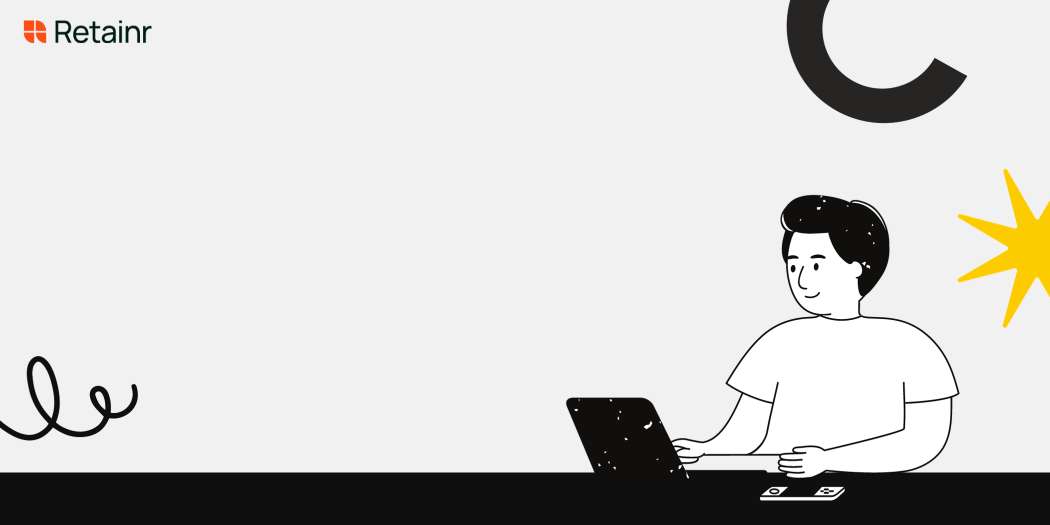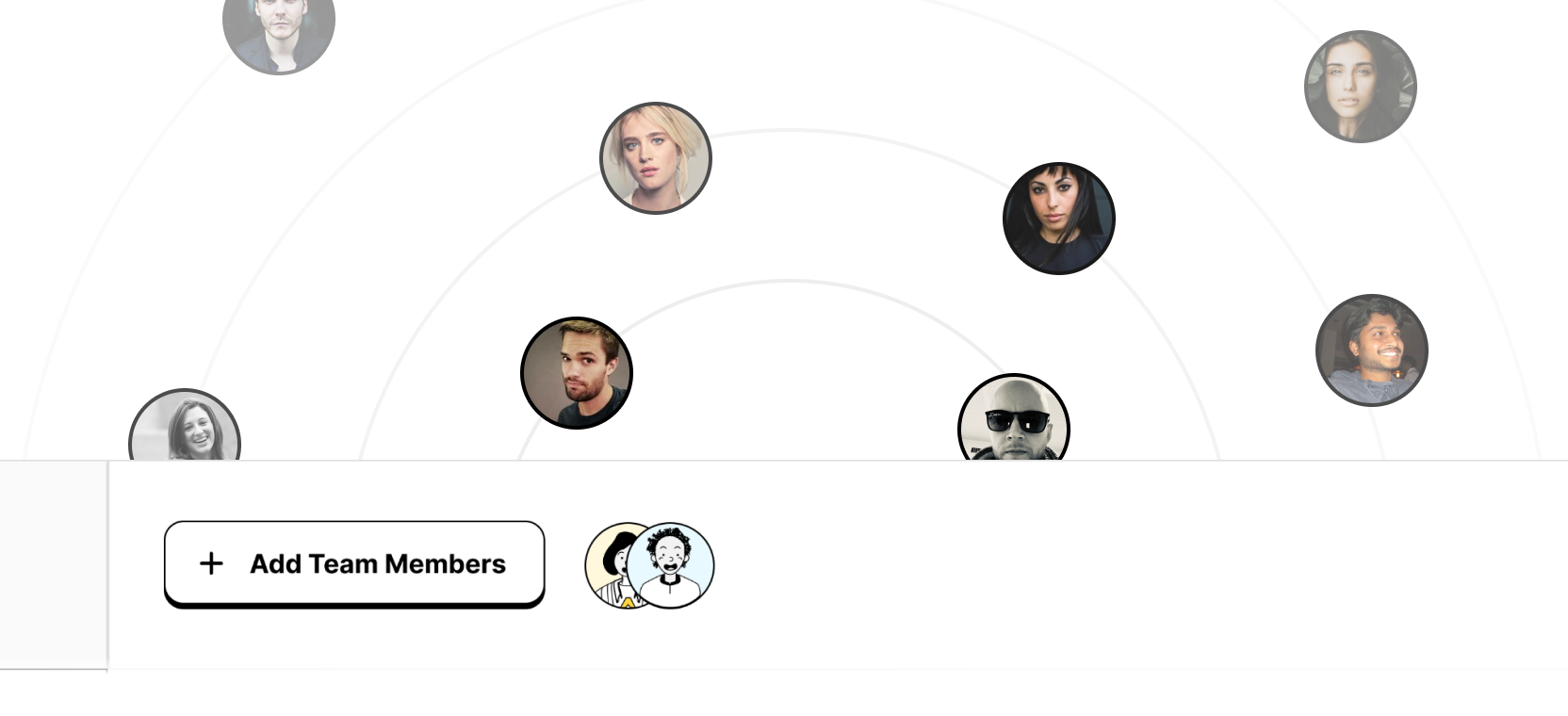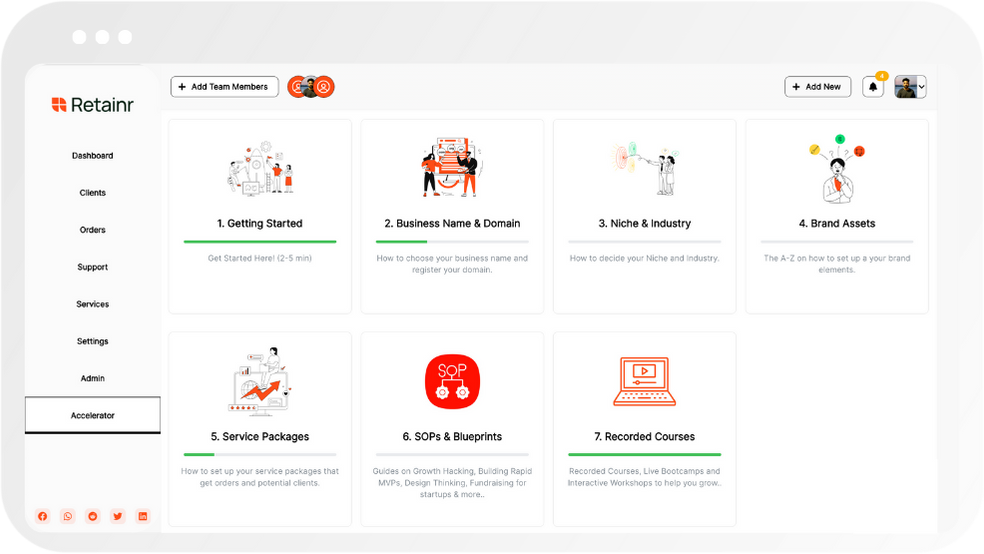
Navigating Client Relationships: 7 Tips for Successful Freelancing
Build with Retainr
Sell your products and services, manage clients, orders, payments, automate your client onboarding and management with your own branded web application.
Get Started1. What are the top tips for handling client relationships as a freelancer?
Understanding Client Needs
At the core of every successful client relationship is a deep understanding of the client's needs and expectations. This starts from the very first interaction and is crucial in defining the trajectory of the project. Here are some tried-and-tested tips to efficiently understand client needs:
- Ask questions: Always ask pertinent questions at the beginning to have a clear idea of the project requirements.
- Be an active listener: This can help you understand not only spoken requirements but also the subtext behind them.
- Research: Do your homework on the client's industry and competitors.
Communication is Key
Effective and timely communication is the backbone of any successful freelancer-client association. It's not just about sharing your updates, but also about making sure your client knows what's happening at each step. Here are a few tips for better communication:
- Choose the right medium: Whether it's email, phone calls, or face-to-face meetings, select the communication method your client prefers.
- Be prompt: Be available to address client calls and emails in a timely manner.
- Clarify doubts: Don't assume things. If you have any doubts, ask and clarify.
Meeting Deadlines and Managing Expectations
A freelancer's credibility is often measured by how well they meet deadlines and manage client expectations. It's a delicate balancing act, but by following some simple practices, it can be made easier:
| Practice | Description |
|---|---|
| Proper Planning | Set a realistic timeline for each project milestone and stick to it. |
| Setting Priorities | Determine the priority of tasks based on importance and urgency. |
| Constant Updates | Keep clients in the loop about your progress to avoid last-minute surprises. |
2. How can I improve my communication with clients as a freelancer?
Improving Communication as a Freelancer
Communication is the heartbeat of any business, and as a freelancer, your ability to communicate effectively with clients can make or break your success. Consider the following practical tips:
- Establish Effective Channels of Communication: Choose the right platforms that suit both you and your clients. Emails, phone calls, video calls, or a project management tool, make sure it's convenient for both parties.
- Clear and Concise Communication: Resist from using complex words or sentences. Keep your messages precise and clear to avoid any misunderstanding.
- Regular Updates: Provide consistent updates on the progress of projects. This creates trust and shows your commitment to the work.
- Responsive: Timely responses to your client's queries demonstrate your professionalism and reliability.
Understanding Your Client's Communication Preferences
To further enhance your communication skills, you may need to understand and adapt to your clients' communication preferences. The table below outlines different communication styles and how best to engage them:
| Communication Style | How to Engage |
|---|---|
| Direct and Expressive | Be concise and get straight to the point. |
| Formal and Detailed | Provide comprehensive explanations and include detailed plans. |
| Visual | Use graphs, charts, and other visual materials to support your message. |
| Collaborative | Encourage feedback and engage them in the decision-making process. |
Building Strong Relationships through Effective Communication
In addition to using the right communication style, building a strong relationship with your clients is central to your freelancing success. Here are some strategies:
- Show Empathy: Showing understanding towards your clients' needs and challenges will make them feel valued and seen.
- Express Gratitude: A simple thank you after a project completion or contract renewal makes clients feel appreciated.
- Adaptability: Being flexible and open to changes will demonstrate your eagerness to meet the client's needs.
- Integrity: Be transparent in your dealings, including any potential problems or delays in the project. Trust is fundamental to any successful business relationship.
3. Why is good communication crucial for a successful freelancing career?
Importance of Good Communication in Freelancing
Good communication stands as the bedrock of a successful freelancing career, so why is it so vital? Firstly, it enhances client understanding. Clear communication ensures that you and your client are on the same page, reducing the chances of misunderstandings and disagreements. Secondly, it promotes trust and transparency between you and your client, as you are able to discuss projects, expectations, and deadlines openly. Lastly, effective communication serves as a tool for negotiating better terms for your work, such as pricing, deadline extensions, and extra work demands.
- Enhances client understanding: Clear communication ensures that you and your client have a mutual understanding of the project requirements, deadlines, payment terms, etc. This minimizes the chances of confusion, disagreements, or unfulfilled expectations.
- Promotes trust and transparency: A freelancer who communicates effectively fosters a sense of trust and transparency with the client. By being open and clear about project statuses, potential challenges, and needs, you enable a smoother working relationship.
- Negotiation tool: Good communication skills come in handy when negotiating better terms for your work. This includes anything from project pricing to extensions on deadlines and managing scope creep (when a project expands beyond its originally agreed-upon parameters).
Communication Techniques for Successful Freelancing
The following table highlights some communication techniques you should adopt to flourish in your freelancing career. There’s room for flexibility in your approach, though, as every client may prefer different communication styles and mediums.
| Communication Technique | Description |
|---|---|
| Active Listening | Focus on understanding your client's instructions and feedback by giving them your full attention. |
| Written Documentation | Keep a written record of all project details, deadlines, payments, terms, etc., to avoid confusion or disagreements later on. |
| Regular Updates | Keep your client informed about your progress, potential delays, and any challenges you encounter along the way. |
| Non-verbal communication | Remember to leverage non-verbal cues such as body language, tone of voice, and facial expressions during video calls with clients to ensure the effective delivery of your message. |
4. How should a freelancer respond when a client is unhappy or dissatisfied?
Responsive Communication
When faced with an unhappy client, the first step a freelancer should take is responsive communication. Make sure to acknowledge the client’s dissatisfaction and assure them you are working towards a resolution. Initial reactions in such situations matter a lot and hence, it is crucial to handle the conversation tactfully. How you respond signifies your professionalism. As a freelancer, you should:
- Act promptly.
- Respond calmly and professionally.
- Acknowledge the issue.
- Assure them you are working towards a resolution.
Addressing the issues
After recognizing the client's concerns, understanding the root of their dissatisfaction is crucial. This might be due to the quality of work, delays in submission, or lack of communication. Whatever the cause, it is essential to address this issue with the client and make the necessary corrections to your work. Effective problem solving involves:
| Action | Explanation |
|---|---|
| Identify the problem | Understand why the client is not happy. |
| Address it promptly | Propose potential solutions rather than excuses. |
| Amend your work | Refine and rework your output to meet their requirements. |
| Prevent it from happening again | Learn from your mistakes and avoid them in future projects. |
Change in Scope of Work
Lastly, sometimes the client may be unhappy because the scope of work has evolved, and your current work does not meet their updated expectations. If this is the case, it's important to have a conversation to revise the scope, the pricing and the timeline. Here's how you should handle this situation:
- Engage in open communication.
- Update the contract to reflect the changes.
- Consider asking for a reasonable additional fee if the workload increases significantly.
- Set accurate expectations to prevent any future dissatisfaction.
5. What steps can a freelancer take to ensure a lasting relationship with clients?
Establishing Trust and Reliability
Trust and reliability are significant for a lasting freelancer-client relationship. Here are some steps that can help freelancers foster strong relationships with their clients:
- Deliver Quality Work: Clients value quality and accuracy. Therefore, prioritising high-quality output can enhance your reliability.
- Meet Deadlines: Punctuality in meeting deadlines shows professionalism and respect for the client's time.
- Be Responsive: Quick response to queries, updates or changes signals your commitment.
- Address Issues Promptly: If problems arise, address them openly and swiftly with the client.
Maintain Open and Positive Communication
Maintaining open and positive communication is another key aspect of a successful client relationship. Here are some tips:
- Provide Regular Work Updates: Regular updates ensure that both you and the client are on the same page.
- Give and Accept Feedback: Constructive feedback helps in refining the work, and accepting feedback shows your willingness to improve.
- Be Respectful and Professional: Even in disagreements, maintain professionalism and respect.
Building a Successful Freelancer-Client Relationship
| Aspect | Importance | Implementation |
|---|---|---|
| Trustworthy and Reliable | Forms foundation of the relationship | Deliver high-quality work, meet deadlines, be responsive, and address issues promptly |
| Open and Positive Communication | Keeps workflow seamless and ensures understanding | Provide regular work updates, give and accept feedback, maintain professionalism |
6. How can freelancers foster a positive relationship with their clients?
Establishing Effective Communication
Effective communication is one of the most critical aspects of a healthy client-freelancer relationship. Freelancers should ensure to:
- Respond to client queries promptly and professionally.
- Ask for clarifications or further details when requirements are not clear.
- Keep the client in the loop about project progress, potential obstacles and solutions.
Delivering Quality Work and Meeting Deadlines
Quality work and adherence to deadlines are key elements in garnering client satisfaction. A freelancer can reinforce this by:
| Quality Work | Meeting Deadlines |
|---|---|
|
|
Openness to Feedback and Revisions
A freelancer should not only be open to feedback but also willingly accept necessary revisions. This ongoing process aids in:
- Deepening understanding of the client's needs and expectations.
- Building mutual respect and trust.
- Delivering a final output that aligns perfectly with the client’s vision.
7. How should I tackle disagreements or conflicts with clients as a freelancer?
Tackling Disagreements or Conflicts Effectively
Disagreements and conflicts are a common occurrence in client relationships, especially as a freelancer. It's important to handle such situations professionally and efficiently. Here are a few pointers to keep in mind:
- Maintain Open Communication: Always be explicit about your capacities and limitations from the start to avoid unnecessary misunderstandings later.
- Negotiate Constructively: When conflicts arise, approach discussions with an open mind and a goal of reaching a mutually satisfactory solution.
- Stay Calm: Emotional reactions during disagreements often escalate the situation. Keep your emotions in control, and be patient and understanding, even if the client is not.
- Document Everything: Keep track of all communications and work changes. Documentation serves as evidence if disputes escalate beyond regular exchange.
How to Respond to Common Disagreements
While the ideal scenario would be to avoid any disagreements, you should be prepared to address any issues that arise. Here is a table to guide you on how to respond to common freelancer-client disputes:
| Conflict | Response |
|---|---|
| Miscommunication about project scope | Refer to your documented communications about the project and clarify the scope and expectations. Propose steps to reconcile any differences. |
| Delayed or non-payment | Politely remind the client about the due payment, speak about your payment terms, and consider renegotiating contract terms if necessary. |
| Changes in project scope (scope creep) | Discuss how these changes affect your work and renegotiate terms, deadlines, and prices as necessary. |
Protecting Yourself as a Freelancer
Preventing and managing disputes are critical, but so is the need for protecting yourself as a freelancer. Always have contracts in place that outline the scope of work, payment terms, and processes for dealing with potential disagreements. Be sure to hire a lawyer if you encounter a massive dispute. The most important thing, however, is to build strong, respectful relationships with your clients. This will not only prevent disagreements but will also enhance your reputation as a freelancer, helping you secure more clients in the future.
8. What are some common struggles freelancers face when dealing with clients and how can they be overcome?
Common Struggles Freelancers Face When Dealing with Clients
Freelancers often have to grapple with a variety of challenges while interacting with clients. Notable among them are:
- Irregular Payments: Freelancers often struggle with late payments, even after delivering work as per the agreed timeline and quality.
- Work Scope Creep: Clients sometimes start demanding more work than was initially agreed upon without being willing to pay extra.
- Unrealistic Expectations: Some clients expect freelancers to be available at all times, disregarding the fact that they may be handling other projects as well.
Overcoming These Struggles
While these challenges may seem daunting, there are practical ways to handle them:
- Establishing Clear Payment Terms: Draft a contract that defines when the payment should be made and institute a penalty for late payments.
- Well-Defined Scope: Before starting any project, ensure there is a written agreement about the scope of work to prevent any last-minute surprises.
- Set Clear Boundaries: Communicate your working hours and availability from the start to align expectations.
Comparison of Problems and Solutions
| Problem | Solution |
|---|---|
| Irregular Payments | Establishing Clear Payment Terms |
| Work Scope Creep | Well-Defined Scope |
| Unrealistic Expectations | Set Clear Boundaries |
9. How can freelancers adapt to different communication styles of different clients?
Identifying Communication Styles
Every client is unique and so is their communication style. This is why one of the first steps for freelancers is to understand and identify different communication styles. There are primarily four types: assertive, passive, passive-aggressive, and aggressive.
| Style | Description |
|---|---|
| Assertive | Open, direct, and respects the rights of others. |
| Passive | Avoids conflict, struggles to express their needs. |
| Passive-aggressive | Appears passive on the surface but acts out indirectly. |
| Aggressive | Attempts to dominate, disregards the rights of others. |
Adapting to Communication Styles
Once the client's communication style has been identified, freelancers can then adapt their own style to create a harmonious working relationship.
- Assertive: Be straight to the point and respect their time, but also stand your ground firmly (yet politely) when needed.
- Passive: Encourage open communication and assure them their opinion is valued. Regularly ask for feedback.
- Passive-aggressive: Respond with positivity and patience. Avoid being confrontational but make sure to address any unspoken concerns.
- Aggressive: Maintain professionalism and respect. Set boundaries and avoid getting into heated arguments.
Emphasizing Active Listening
Regardless of the communication style, listening to your client's needs, feedback, and concerns plays an important role in effective communication.
- Pay attention to what is being said and also what is left unsaid.
- Always ask clarifying questions if you don't understand something.
- Show empathy and understanding in your responses.
- Summarize or paraphrase what the client said to ensure you fully understand their point of view.
This approach not only helps in adapting to different communication styles, but also builds trust and strengthens the relationship with the client.
10. How might one manage expectations for both the freelancer and the client?
Manage Expectations for Freelancer and Client
Effectively managing expectations is crucial for the success of a freelancer-client relationship. It's essential that both parties understand and agree on the specifics of the project, including deliverables, timelines and payment terms. Here are some ways to facilitate this process:
- Set Clear Objectives: Establish the project's goals at the start. Ensure everyone has a mutual understanding of what is to be achieved.
- Create A Comprehensive Contract: A well-drafted contract can prevent a lot of misunderstandings. It should detail project specifics, responsibilities, deadlines, payment details, and procedures for dealing with any potential issues.
- Effective Communication: Regularly update the client with your progress. Notify them of any issues as early as possible to prevent surprises.
Engage in Open Discussions
Open communication forms the basis for managing expectations. Without it, misunderstandings may develop, disrupting the progress of the project. Facilitating open discussions can ensure smooth operations:
| Discussion Topic | Why It's Important |
|---|---|
| Project Scope | Clearly defining the project scope prevents scope creep and keeps the project on track. |
| Feedback and Revisions | To ensure the delivered work meets the client's expectation, determine the procedure and number of revisions in advance. |
| Time and Expense Tracking | A transparent record of time and expenses is essential for billing and reassures the client that their money is well-spent. |
Use of Project Management Tools
Project management tools can provide a structured way to manage expectations. They not only aid in communication but also in tracking progress, setting realistic deadlines, and addressing issues efficiently. Here are some tools worth considering:
- Asana: Access tasks, deadlines, and deliverables all in one place.
- Slack: Centralize communication and avoid miscommunication due to scattered conversations.
- Trello: Track project progression visually and manage tasks more efficiently.
Conclusion
Summary
This blog discusses the nuances of building and navigating successful client relationships as a freelancer. The discussion encompasses 7 fruitful tips serving as a roadmap to assist freelancers to manage their clients, projects, orders, and financial transactions effectively. The tips range from setting clear expectations, effective communication, being consistent and reliable, respecting deadlines, offering top-notch service, being flexible yet principled to fostering long-term relationships.
The Importance of a Reliable Management Software
In conjunction with these tips, the blog excitingly highlights the need for a reliable management software system. If you're a freelancer seeking a seamless way to sell, manage clients, orders, and payments, you're in luck. The blog introduces Retainr.io, a white-label software designed to aid your freelance business operations. With a branded app exclusively for your enterprise, it makes your client management effortless and professional.
Scaling Your Freelancing with Retainr.io
The software package, Retainr.io, serves as your personal assistant helping you to navigate, nurture and scale your client relationships. It's a sure way to implement the tips shared in the blog and become more organized, transparent, productive, and successful in your freelance business.
Take Control of Your Businesses with Retainr.io
With Retainr.io, you can pay attention to what you do best, leaving the management to the software. Understanding the intricacies of freelance business operations, the software delivers precisely what you need to stay updated and ahead in this competitive sphere. So take charge, embrace Retainr.io and revamp your freelancing career.
Boost Your Agency Growth
with Retainr Accelerator
Uncover secrets, strategies, and exclusive blueprints to take your agency's growth to the next level — from marketing insights to effective presentations and leveraging technology.

SOPs, Cheatsheets & Blueprints
Leverage 50+ SOPs (valued over $10K) offering practical guides, scripts, tools, hacks, templates, and cheat sheets to fast-track your startup's growth.
Connect with fellow entrepreneurs, share experiences, and get expert insights within our exclusive Facebook community.
.jpg)

Join a thriving community of growth hackers. Network, collaborate, and learn from like-minded entrepreneurs on a lifelong journey to success.

Gain expertise with recorded Courses, Live Bootcamps and interactive Workshops on topics like growth hacking, copywriting, no-code funnel building, performance marketing and more, taught by seasoned coaches & industry experts.

.jpg)

.jpeg)


